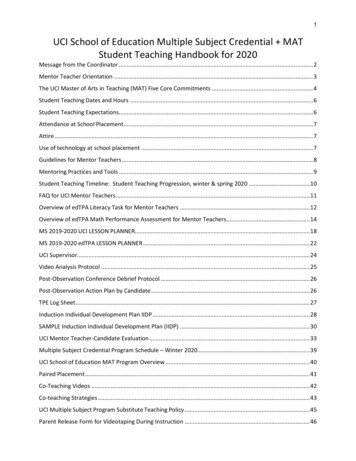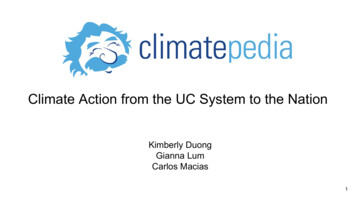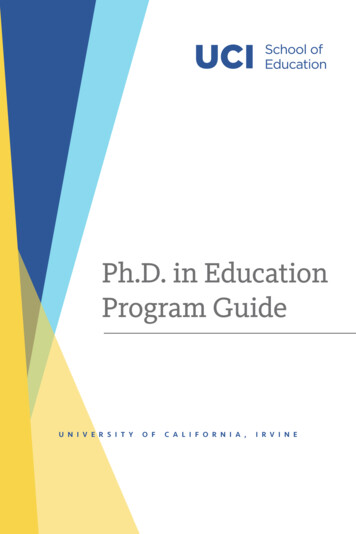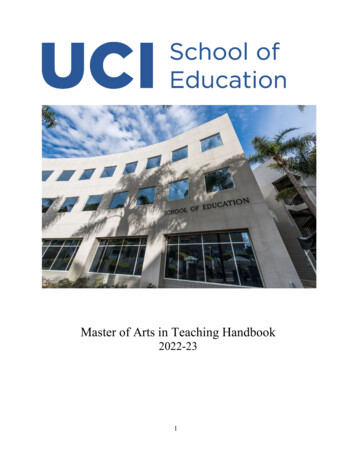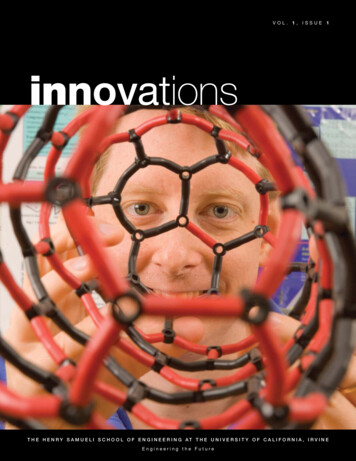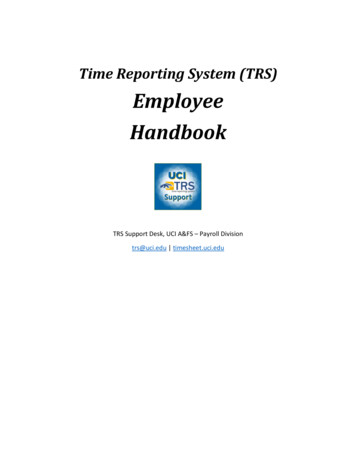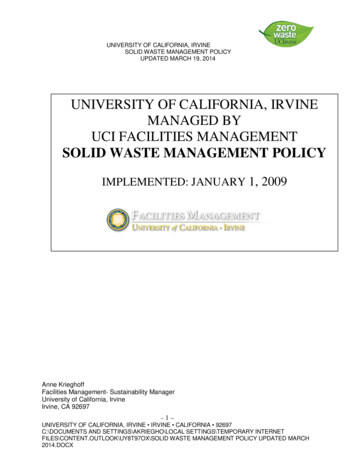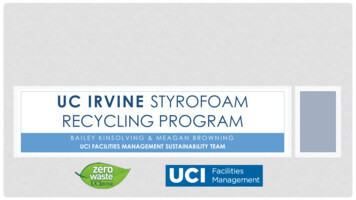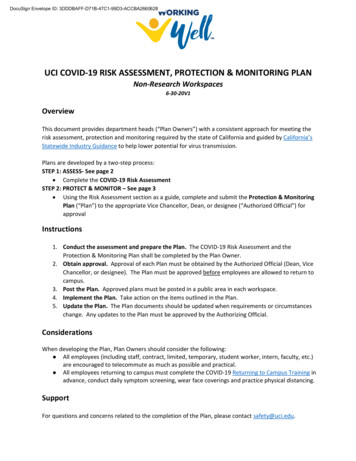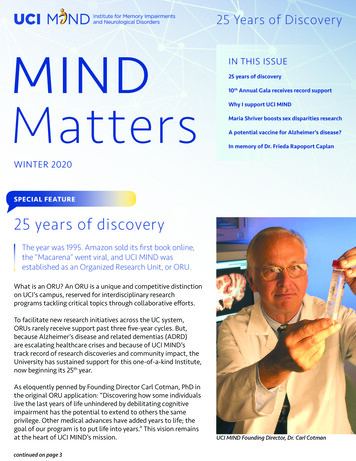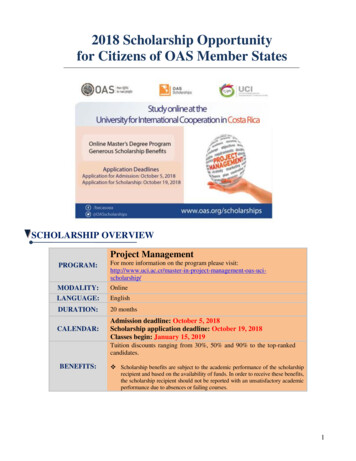
Transcription
1UCI School of EducationMultiple Subject Credential MATMentor Teacher Handbook for Spring Quarter 2017Invitation to a Mentor Teacher Orientation . 2UCI MAT – Learning to Teach – Teaching to Learn. 3The UCI Master of Arts in Teaching (MAT) Five Core Commitments . 3Student Teaching Dates . 5Student Teaching Expectations. 6Student Teaching Timeline . 7Guidelines for Mentor Teachers . 8Evaluations . 9Teacher Performance Expectations (TPEs) . 9FAQ for UCI Mentor Teachers. 10UCI Supervisor. 12University of California, Irvine – Multiple Subject Credential Program Schedule – Spring 2017 . 13UCI School of Education MAT Program Overview . 14University of California, Irvine - Post-Observation Conference Protocol . 15OBSERVATION AND POST OBSERVATION CONFERENCES . 17Math Observation Rubrics . 18All Other Observations Rubrics . 23Sample Long Term Planner for Solo Placement . 28Sample Long Term Planner for Paired Placement . 29Paired Placement . 30Co-Teaching Videos . 31Co-teaching Strategies . 32UCI Mentor Teacher-Candidate Evaluation . 34UCI Multiple Subject Program Substitute Teaching Policy . 41For additional information, please contact theMultiple Subject Coordinator, Susan Toma-Berge at tomas@uci.edu or (949) 824-4172.
2UCI School of EducationInvitation to a Mentor Teacher OrientationMonday, April 24th4:00-5:30 pmRoom 2010 in the Education Building3200 Education Building, Irvine, 92697Please join us to learn more about the UCI program andstrategies for mentoring.Topics to include:Co-teachingReflective conferencesProviding feedbackPlease RSVP hereA parking permit and refreshments will be provided.
3UCI MAT – Learning to Teach – Teaching to LearnThe UCI Master of Arts in Teaching (MAT) Five Core CommitmentsEquity: We are committed to preparing candidates who understand the challenges that students fromtraditionally under-served populations experience in school, who develop agency to advocate forunderserved student populations and who have a commitment to addressing inequities that reside in theeducational system. We draw on research on equity in schooling to inform the design of courses andlearning experiences to support candidates in developing attention to issues of equity in teaching.Understanding Learners & Learning: We are committed to preparing candidates who focus on learnersand learning. We prepare candidates to understand who the learners are in their classrooms and how todesign instruction that draws on the competencies and knowledge that students bring to bear on theirlearning. We also provide candidates with experiences to study theories of learning and development,while also observing and reflecting on those theories in context. Candidates use these experiences toguide instructional planning and decision-making.
4Teaching and Learning in the Content Areas: We are committed to preparing candidates toteach in the content areas and to developing their content knowledge for teaching and pedagogical practicesunique to the discipline. Using practice-based approaches to teacher preparation, candidates learn high leveragepractices for teaching in the content areas.Learning from Practice: We are committed to preparing candidates to learn in and from their practice. Teachercandidates cannot learn all they need to learn in teacher preparation but they can learn how to systematically inquireabout teaching and learning, collect data to provide insight on instruction, and use what they learn throughprofessional collaboration to improve their practice.Leadership: We are committed to preparing candidates who will become leaders in their school. We useinnovative approaches to teacher education to cultivate their practices forleading teacher learning once they become teachers.
5Student Teaching DatesSpring Quarter 2017 UCI Classes begin the week of April 3rd, 2017.Student Teaching begins: April 3rdStudent Teaching ends: last day of schoolMid-Term Evaluation for Mentor Teachers: May 5thFinal Evaluation for MTs and Supervisors: May 29th
6Student Teaching Expectations A full school day is defined as arriving a minimum of one half hour before the first bell and leaving no earlierthan one half hour after the end of the school day. You are expected to remain after school with your MT to prepare and plan for upcoming lessons. The hours forplanning will be determined in collaboration with the MTDuring the winter and spring quarters, student teachers must: Demonstrate professional communication and conduct throughout the student teachingassignment. Demonstrate developing competency in the areas of instructional and curricular planning,instruction, assessment, reflection and classroom management. Participate with the mentor teacher in collaboration and co- ‐teaching. Demonstrate readiness to assume full- ‐time student teaching responsibility. Schedule and participate in regular planning and reflective meetings with the mentorteacher throughout the student teaching assignment. Conference with Supervisor after each observation visit.
7Student Teaching TimelineThis is a suggested timeline for the gradual assumption of responsibility. Mentor Teachers and Student Teachers willcollaborate to determine the most developmentally appropriate timeline.Week 1-Observe and participate Monday-Friday-Get involved in the daily routines-Demonstrate initiative-Collaborate and communicate-Use the classroom management system-Co-teach with your mentor (one teach/one assist)Week 2 Collaborate with your MT (and partner) about what subject (or group) you are prepared to take the lead role. Plan and teach that subject for the week Co-teach all other subjects with your MT and partnerWeek 3 Collaborate with your MT (and partner) about which 2 subjects (or groups) you are prepared to take over thisweek. - Continue to co-teach all other subjectsWeeks 4-8-Continue adding one more subject or groupTeach and record your edTPA segmentWeeks 9-10-You (and your partner) are responsible for teaching/co-teaching the full day.As student teachers take on responsibility for planning and teaching, as full UCI Lesson Planner is not required. Instead,Student Teachers may use any format that has been approved by their Mentor Teacher. Some MTs like to see an outlineof the lesson with a learning goal, some like to see the assessment, and others like to see the topic to be taught. Pleaseconsult with the Coordinator, Susan, or the Supervisor, if you would like a sample.
8Guidelines for Mentor TeachersProfessional Communication Set up two- ‐way Norms for professional communication, demeanor and other important items thatwill contribute to a healthy working relationship . Work with your candidate on setting goals, discussing progress and revising goals over the10 weeks.Planning Plan a schedule for the assumption of teaching responsibilities with the candidate. The candidate isresponsible for completing a Long Term Planning Chart in collaboration with the mentor teacherand submitting it to their UCI Program Coordinator. The goal is to scaffold the candidate to assumeresponsibility for planning and instruction in all content areas independently for a minimum of 2weeks. Plan for the assumption of Math instruction first, in preparation for completion of theTeaching Event.Support Assist the candidate in becoming familiar with the schedule, curriculum, classroommanagement system, record- ‐keeping system, and the students in your classroom. Assist the candidate in becoming familiar with school facilities, policies, and procedures. Conference with and provide feedback to the candidate on a regular basis. Participate in collaborative planning and co- ‐teaching, as well as analyzing studentassessments. Model how to make instructional decisions based on student learning. Provide a positive role model for the candidate in all aspects of teaching, includingprofessional conduct and communication, planning, instruction, management andassessment.
9EvaluationsMentor Teachers will be asked to complete an evaluation of their Student Teacher(s) based on the Teacher PerformanceExpectations. An email from Chalk & Wire will be sent that contains the evaluation. Before filling out the survey online,Mentors will be sent a list of the evaluation criteria so they may conference with their Student Teacher. StudentTeachers are then required to submit a reflection that includes goals for improvement. The Coordinator, Susan TomaBerge, will send out a notice a week before the Chalk & Wire email.Mid-Term Evaluation: May 5thFinal Evaluation: March 29thTeacher Performance Expectations (TPEs)TPE 1: Engaging and Supporting All Students in LearningTPE 2: Creating and Maintaining Effective Environments for Student LearningTPE 3: Understanding and Organizing Subject Matter for Student LearningTPE 4: Planning Instruction and Designing Learning Experiences for All StudentsTPE 5: Assessing Student LearningTPE 6: Developing as a Professional EducatorMentor Teachers will also be asked to complete an evaluation of the UCI Supervisor who is assigned to your StudentTeacher.
10FAQ for UCI Mentor TeachersHow do I contact someone at UCI if I have questions or concerns?-Please feel free to contact Susan Toma-Berge at tomas@uci.edu or (949) 328-4824.How do I ensure my candidate understands my expectations?-Set up clear and detailed NORMs; revise as needed.How do I encourage collaboration, reflection and feedback?-Model these behaviors, tell your ST this is what you want to see, ask a lot of questions, ask your ST to ask youquestions, have them observe collaboration meetings, provide opportunities for STs to give/get feedback, createa safe environment where they know it is okay to make mistakes, and create a consistent time and place forcollaboration to take place each week.What do I do if my student teacher is sitting in the back of the room, taking notes, and not engaging in activeparticipation?-Talk to your ST about what “active” looks like/sounds like. Should they be assisting particular students?Working with small groups? Be explicit.How do I approach my candidate if I have some serious concerns?-Select a day/time to engage in a thoughtful conversation. Be honest, start with positive feedback, and mentionthat you care and want your ST to succeed. Ask your candidate to reflect on the issue at hand and have a planfor improvement.What is the expectation for candidate taking over the entire class?-During fall quarter candidates are to be engaged in active observation, participation, leading routines, teachingsmall groups, and instructing a few whole class lessons. They should not be taking over the entire day as this istheir time to learn from a mentor teacher.Can I leave my candidate(s) alone in the room?-Only for short periods of time. As the teacher of record, mentors are legally responsible for the well being ofclassroom students.What should I use to provide my student teacher with feedback? Coaching tool?-Although they are not yet student teachers we encourage you to use the UCI Post-Observation ConferenceProtocol to ask your candidate questions that focus on the learning goal, evidence of student learning and nextsteps.Do I need to complete any formal observations or paperwork?-At the end of the quarter I will send you a line to complete a short evaluation. This is not the same as theMentor Teacher Candidate Evaluation that you complete during winter/spring. This survey will give you anopportunity to communicate with UCI about your candidate’s competency, professionalism, strengths and areasof concern.
11What should I do if my candidate is:-Consistently tardy?Racing out the door at the end of the day (and it’s not for UCI class)?Wearing inappropriate clothing?Speaking to parents about individual student progress?Talking/texting on cell phone during the instructional day?Other professional conduct issues or concerns?Have a conversation with your ST immediately, explain your expectations, revise your norms, contact Susan Toma-Berge,and document the concern, evidence as well as conversations.
12UCI Supervisor The UCI Supervisor’s main goal is to support your Student Teacher’s progress toward becoming a teacher. Student Teachers will meet their UCI Supervisor at the Winter Orientation on January 13th to discuss sharedexpectations, schedule observations and Q/A. A Supervisor is UCI faculty who will formally observes the Student Teacher a minimum of 4 times a quarter. After each formal observation the Student Teacher will conference with the Supervisor and Mentor Teacher (ifavailable). Supervisors monitor Student Teacher progress on the edTPA, CATs and Student Teaching Binder. The Supervisor will maintain communication with Student Teachers, Mentor Teachers and the Coordinator(Susan T.) about progress.
13University of California, Irvine – Multiple Subject Credential Program Schedule – Spring 2017April 3rd – June 16thCOHORT A - All courses should be selected for a grade BCLAD Candidates enroll in ED306, not ED 304.UNITS CRSCOURSETITLECODEED 3041212695 STDNT TCHG ELEM SCHL – Meets three times during the quarter; detailsin syllabus.ED 3061212705 BCLAD STDNT TCHG – Same as ED 304 for candidates in dual immersionclassroomsED 359412760 Social Studies and Information LiteracyDAYM/TBAM/TBAWED 247THED 363212770412460Arts Integration, meets the first 5 weeks of spring quarterTeaching Investigation: Exploring the Dilemmas of PracticeCOHORT B - All courses should be selected for a grade. BCLAD Candidates enroll in ED306, not ED 304.COURSEED 304ED 306359ED 363ED 247UNITS12CRSCODE12700412765TITLESTDNT TCHG ELEM SCHL – Meets three times during the quarter;details in syllabusBCLAD STDNT TCHG – Same as ED 304 for candidates in dualimmersion classroomsSocial Studies and Information Literacy12465Teaching Investigation: Exploring the Dilemmas of Practice1224 1270512775Arts Integration, meets the first 5 weeks of spring 30-7:205:00-7:50*Candidates are required to continue with student teaching until the last day of the district calendar year.20102009MPAA330Toma-BergeBurgeGuarino/Tunney
14UCI School of Education MAT Program OverviewStrandClassroom Teaching andMethods: The courses inthis strand aim to helpcandidates developeffective teachingpractices that supportstudents’ learning inclassrooms.Summer 1Session 1Summer 1Session 2364 Instructional Designand Ed. Technology inthe ElementaryClassroom (2)323A Science Methods(2)FallWinterSpring301 Fieldwork Seminar(2)304 Student TeachingSeminar (8)304 Student TeachingSeminar (12)323B Science Methods(2)326 Methods forElementary Reading (4)Summer 2Session 1359 Social Studies andInformation Literacy (4)325 Teaching Visual andPerforming Arts (2)363 Arts Integration (2)362 ELA/ELD (4)320 P.E./Health (4)202 Outcomes ofSchooling -- StudentAssessment (4)The Learner: The coursesin this strand aim tosupport candidatesdeepen theirunderstanding aboutlearners across variousdevelopmental stagesand their needs.Context & Culture: Thecourses in this strand aimto help candidatesdeepen theirunderstanding abouthistorical, political, socialcontexts of schooling andthe issue of equity.Research & Inquiry: Thecourses in this strand aimto support candidatesbecoming teacherleaders who canunderstand and solveproblems of practice.374 Learning and ChildDevelopment (4)90 Quarter Units10322A Math Methods (4)322B Math Methods (4)348 Educational Equityand the ExceptionalLearner (2)241 Children’s SenseMaking (Science) (2)230 The History andCulture of Schooling inthe United States (4)ED 243 The PolicyEnvironment of Teaching(2)10347 Culture, Diversityand Educational Equity(4)24246 TeachingInvestigation:Identifying Dilemmas ofPractice (4)247 TeachingInvestigation: Exploringthe Dilemmas of Practice(4)248 UnderstandingTeacher Agency (4)20224
15University of California, Irvine - Post-Observation Conference ProtocolAfter you have established a comfort level and addressed the candidate’s state of mind, use this process to optimize reflection on action and reflection forfuture action.TRANSITIONING TO AN ANALYTICAL & REFLECTIVE MODELet’s think together about your lesson to see what we can learn about your impact on student learning. . .Now that we’ve both shared some impressions about how your lesson went, let’s unpack one or two key moments of the lesson. . .CLARIFY OUTCOME What was the desired knowledge, understanding, or skill of the lesson? (TPE 3, 4)LEARNING How do you know that the students made progress toward that goal or are still struggling with the lesson topic? (TPE 5; edTPA 8)How did your planning impact all students’ access to the learning goal? TPE 4(UDL)How did you build off of your students’ Funds of Knowledge and assets? (TPE 3; edTPA 5)How did you activate your students’ prior learning? (TPE 1, 4)How did you push your students to a deeper learning or understanding of the topic? (TPE 3; edTPA 8)EVIDENCE In what way did the learning environment impact student learning? Where are examples of your showing respect for and rapport with thestudents? Did you feel the learning environment was positive or challenging? Why? (TPE 2; edTPA 6) How did you actively engage students in a learning task related to the lesson topic? (TPE 1, edTPA 7) What strategies did you use to make student thinking visible in the lesson? What did you see when you employed those strategies? What did youlearn about their thinking? (TPE 3; edTPA 8) What kind of questions did you ask the students to elicit student thinking? Were you able to build on students’ responses to deepen or clarifystudent knowledge of the topic? (TPE 1, 4; edTPA 8) What kind of feedback did you/will you give to your students? And what will they do with this feedback? (TPE 5; edTPA 5, 7)
16USING A CORE PRACTICE TO GUIDE SELF-REFLECTION AND NEXT STEPS Based on the discussion, review the core practice (edTPA rubric) and identify one that should be the focus of the next lesson in the studentteaching classroom. What alternative strategies related to this core practice (edTPA rubric) could you use when planning and/or implementing your next13 lesson? What changes will you make while teaching your next lesson? Based on student thinking related to the content focus, what are your next steps for instruction? Why are you going to make these changes?STUDENT SELF-REFLECTION Remind the student to select the chosen Self Reflection rubric, fill it out, write a reflection on their assessment and submit it to the Supervisor.
17OBSERVATION AND POST OBSERVATION CONFERENCES Supervisor and Candidate set date for observationCandidate confers with Mentor Teacher then confirms or reschedules dateCandidate sends Supervisor a lesson plan through Chalk & Wire at least 24-48 hours ahead of timeSupervisor responds with feedback if adequate time is givenCandidate and Supervisor decide if there is something specific to be observing based on last observation, or observation goals Supervisor arrives at the school site to observe Candidate teach the lessonIf possible, Supervisor greets and speaks with the mentorCandidate teaches the lessonSupervisor’s observation includes note taking and monitoring of student work After the lesson, Supervisor, Candidate and Mentor Teacher (if available) meet for the Post-Observation Conference The Post-Observation Conference Protocol is used to guide the conversation As a group, one rubric (1, 5, 6, 7 or 8) is selected as the area for growth Within 48 hours of the observation, the Candidate writes a Self-Reflection on Chalk & Wire by selecting a level from one rubric (1, 5, 6, 7, or 8)that was identified at the Post-Observation Conference as an area for growth and respond to both prompts:o Drawing on evidence from your lesson, explain your self-assessment in terms of actively engaging students? See specific rubric on Chalk & Wire to write to the selected level.o What alternative strategies would you use when planning a lesson? See specific rubric on Chalk & Wire and write to the selected level. Submit Self-Reflection to Supervisor through Chalk & Wire Supervisor responds to Candidate Self-Reflection Candidate, Mentor Teacher and Supervisor select this rubric or identify another specific rubric as the focus core practice for the next observation.
18Math Observation RubricsPlanning Rubrics - Rubric 1: Planning for Mathematical UnderstandingsHow do the candidate's plans build students' conceptual understanding, procedural fluency, AND mathematical reasoning or problem solvingskills?Level 1 1Level 2Level 3Level 4Level 5Candidate's plans for instruction focussolely on facts and/or procedures withno connections toCandidate's plans for instructionsupport student learning of facts andprocedures with vague connectionstoCandidate's plans for instructionbuild on each other to supportlearning of facts and procedureswith clear connections toCandidate's plans for instruction build oneach other to supports learning of factsand procedures with clear andconsistent connections toLevel 4 plus: concepts OR concepts OR concepts AND mathematical reasoning or problem- mathematical reasoning or mathematical reasoning or problem- concepts OR mathematical reasoning or problemsolving skills.ORsolving skills.problem-solving skills.solving skills.There are significant contentinaccuracies that will lead to studentmisunderstandings.ORStandards, objectives, and learningtasks and materials are not alignedwith each other.1Text representing key differences between adjacent score levels is shown in bold. Evidence that does not meet Level 1 criteria is scored at Level 1.Candidate explains how they will uselearning tasks and materials to leadstudents to make clear and consistentconnections.
19Math ObservationPlanning Rubrics - Rubric 5: Planning Assessments to Monitor and Support Student LearningHow are the informal and formal assessments selected or designed to monitor students’ conceptual understanding, procedural fluency, ANDmathematical reasoning or problem-solving skills?Level 1Level 2Level 3Level 4Level 5The assessments only provideevidence of students' proceduralskills or factual knowledge.The assessments provide limitedevidence to monitor students'The assessments provide evidence tomonitor students'The assessments provide multipleforms of evidence to monitorstudents' progress toward developingLevel 4 plus:OR conceptual understanding, conceptual understanding, procedural fluency, OR procedural fluency, AND mathematical reasoning or problem- mathematical reasoning or problem-Candidate does not attend to ANYASSESSMENT requirements inIEPs and 504 plans.solving skillsduring the learning segment.solving skillsduring the learning segment. conceptual understanding, procedural fluency, AND mathematical reasoning or problemsolving skillsthroughout the learning segment.The assessments arestrategically designed to allowindividuals or groups withspecific needs to demonstratetheir learning.
20Math ObservationInstruction Rubrics - Rubric 6: Learning EnvironmentHow does the candidate demonstrate a respectful learning environment that supports students' engagement in learning?Level 1Level 2Level 3Level 4Level 5The clip(s) reveal evidence ofdisrespectful interactionsbetween teacher and students orbetween students.The candidate demonstratesrespect for students.The candidate demonstratesrapport with and respect forstudents.The candidate demonstrates rapportwith and respect for students.The candidate demonstrates rapportwith and respect for students.ANDANDCandidate provides a challenginglearning environment that promotesmutual respect among students.Candidate provides a challenginglearning environment that providesopportunities to express variedperspectives and promotes mutualrespect among students.ORCandidate allows disruptivebehavior to interfere with studentlearning.ANDCandidate provides a learningenvironment that servesprimarily to control studentbehavior, and minimallysupports the learning goals.ANDCandidate provides a positive,low-risk learning environmentthat reveals mutual respectamong students.
21Math ObservationInstruction Rubrics - Rubric 7: Engaging Students in LearningHow does the candidate actively engage students in developing understanding of mathematical concepts?Level 1Level 2Level 3Level 4Level 5Students are participating in tasks thatare vaguely or superficially related tothe central focus.Students are participating inlearning tasks focusing primarilyon mathematical skills orprocedures with little attentionto developing understanding ofmathematical concepts.Students are engaged inlearning tasks that addressunderstanding of mathematicalconcepts.Students are engaged in learning tasksthat develop understanding ofmathematical concepts.Students are engaged in learning tasksthat deepen and extend theirunderstanding of mathematicalconcepts.There is little or no evidence that thecandidate links students' prioracademic learning or personal,cultural, or community assets withnew learning.Candidate makes vague orsuperficial links between prioracademic learning and newlearning.Candidate links prior academiclearning to new learning.Candidate links prior academiclearning AND personal, cultural, orcommunity assets to new learning.Candidate prompts students to linkprior academic learning AND personal,cultural, or community assets to newlearning.
22Math ObservationInstruction Rubrics - Rubric 8: Deepening Student LearningHow does the candidate elicit responses to promote thinking and develop understanding of mathematical concepts?Level 1Level 2Level 3Level 4Level 5Candidate does most of thetalking and students provide fewresponses.Candidate primarily askssurface-level questions andevaluates student responses ascorrect or incorrect.Candidate elicits studentresponses related tomathematical reasoning orproblem solving to developunderstanding of a mathematicalconcept.Candidate elicits and builds onstudents' mathematical reasoningor problem solving to explicitlyportray, extend, or clarify amathematical concept.Level 4 plus:ORCandidate responses includesignificant content inaccuraciesthat will lead to studentmisunderstandings.Candidate facilitates interactions amongstudents to develop understanding of amathematical concept.
23All Other Observations RubricsPlanning Rubrics - Rubric 1: Planning for Content UnderstandingHow do the candidate's plans build students' conceptual understanding or understanding of an essential strategy?Level 1 2Level 2Level 3Level 4Level 5Candidate's plans for instruction focussolely on facts, skills and/or procedureswith no connections toCandidate's plans for instructionsupport student learning of facts,skills and procedures with vagueconnections toCandidate's plans for instructionbuild on each other to supportlearning of facts and procedureswith clear connections toCandidate's plans for instruction build oneach other to support learning of factsand procedures with clear andconsistent connections toLevel 4 plus: concepts or strategies concepts or strategies concepts AND concepts or strategiesORCandidate explains how they will uselearning tasks and materials to leadstudents to make clear and consistentconnections. strategiesThere are significant contentinaccuracies that wil
1 UCI School of Education Multiple Subject Credential MAT . Mentor Teacher Handbook for Spring Quarter 2017 Invitation to a Mentor Teacher Orientation.2
